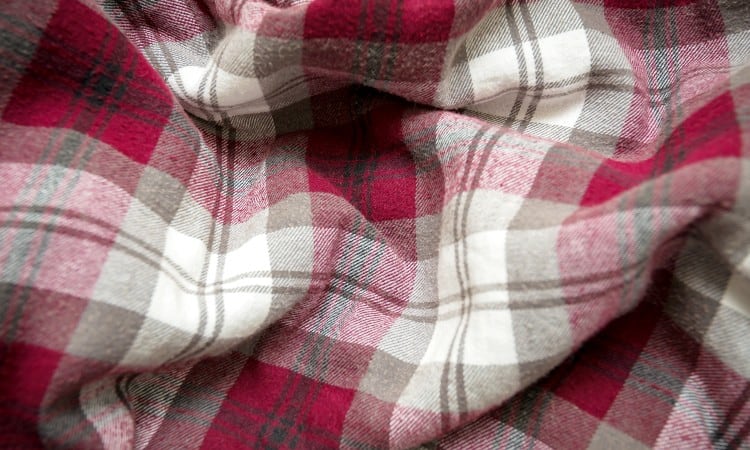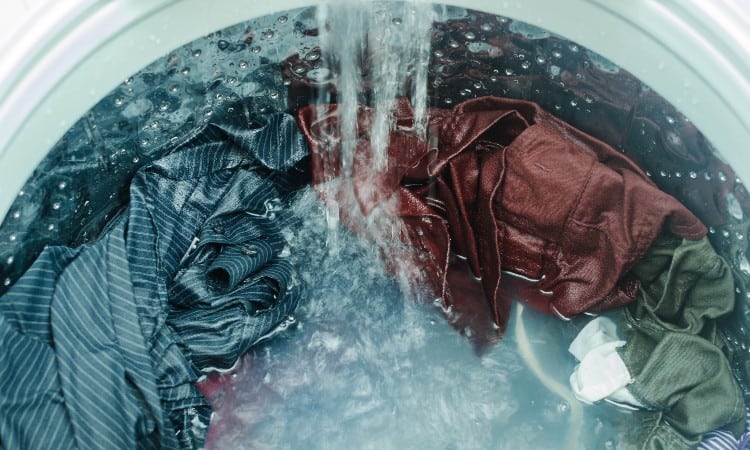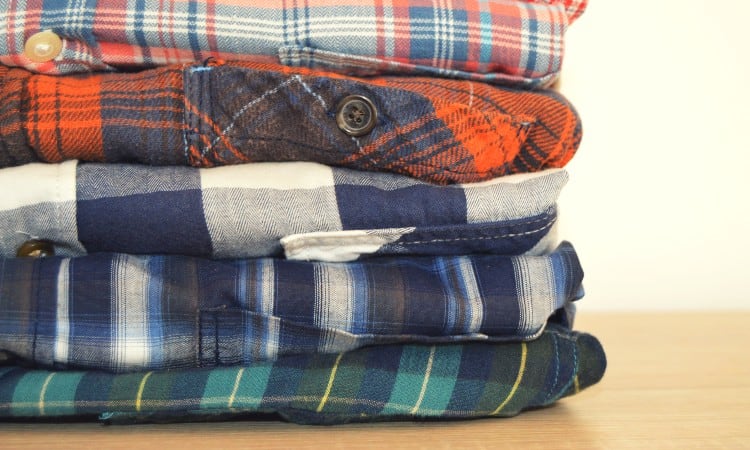You recently bought a flannel shirt that you’re crazy about, and you’re wondering, does flannel shrink? Made from either cotton, wool, or synthetic fiber, flannel is known for its softness, warmth, and sheer comfort. It’s important that you know how to keep its original size forever.
Flannels shrink when exposed to heat. If washed in hot water, this type of fabric will become smaller in size. Flannels also shrink when dried in a hot setting or if you over-dry them. This type of fabric is also prone to shrinkage when they are low-quality.
In this article, we’ll explain what makes flannel shrink, how much it can shrink, and the reasons why it shrinks.

Does Flannel Shrink?
Flannels shrink when you wash them in hot water. By hot water, it means 120 degrees Fahrenheit or higher. This popular fall fabric needs your loving, tender care, so when washing your favorite flannel pajamas, boyfriend’s shirt, or blanket, set your washer to cool water. A low-heat setting, or warm water, is also okay.
Most flannels are made up of wool. Wool is a type of textile fiber that comes from animal hair— such as sheep and goats. The surface of these animal hairs is comprised of microscopic scales. When these scales are exposed to heat, they mesh and shrink, causing the wool to stiffen and get shorter.
Apart from heat exposure, there are other reasons why flannel can shrink. Yes, this fabric is notorious for shrinking when tumbling. Let us count the ways!
Tumbling Action
Some modern-day flannels are made up of 100% cotton. Some say cotton does not shrink when exposed to heat. That’s a complete myth. Cotton shrinks when it tumbles inside your washing machine or dryer.
When washing your flannel in cold water (whether it’s made up of wool, cotton, or synthetics), it is important that you set your washer to a “gentle cycle”. When violently churned, flannel can either shrink, fray, and pill.
Yes, flannel can get stressed and shrink in size when you beat it up with rigorous washing. Be kind to your flannel. If you don’t trust your washing machine, then hand-wash your ultimate cozy fabric.
Low-quality Flannel
If there are good quality flannels, then there are also low-quality ones. Your cheap flannel can shrink over time. It is important to know what to check when you are shopping for one of the coziest and most breathable fabrics on Earth.
First, check the weave. One way to check is by tugging it a little, and if it gets warped a little, then you know you have the poor quality kind. High-quality flannel is a little heavy, full and thick, and has a natural fluff to it. Brush it up against your cheek for its fuzziness. Authentic flannel does not lay flat.
Bad Chemicals
The wrong choice of detergent can kill your flannel and cause it to downgrade in size. Washing with detergents that you merely picked by random is a no-no. Chemicals in your laundry soap, like chlorine, enzymes, and phosphates are dangerous to your winter flannels.
Using a fabric softener is also bad for your flannels. Your fragrant fabric softener contains chemicals that create an invisible coat over the fabric that chokes the fibers. Unable to breathe because of the softener’s barrier-causing chemicals, the fibers can no longer hold the fabric’s shape.
Drying Them Hot
You would not want to remove your flannel shirt from the dryer and be surprised that it has shrunk to the size that would fit someone half your size. Drying this fabric hot will automatically cause your flannel to magically become 2 to 3 sizes smaller. So, it’s not just washing them in hot water, but also drying them in heat, that will damage your flannel.
How Much Does Flannel Shrink?
Washing flannel fabric in hot water can cause it to shrink about 20 percent. That’s a big size change and a waste of money too. So make sure you take heat shrinkage seriously.
So, if you don’t wash it in hot water, will flannel still shrink? Yes, but only a bit. If not properly taken care of, flannel can shrink naturally up to 3 or 4 percent, which could mean 1 inch or more of shrinkage.
Does Flannel Shrink When Washed?

Yes, your flannel – whether it’s worsted or woolen – will shrink when washed, but only when hot water is used. When washed using cold water, or at least water set in low heat, your flannel will be protected from shrinkage. When washed in hot water, expect your flannel to shrink 2 to 3 sizes. That’s about 20 percent of your fabric size. This is why it is advised that when purchasing flannel for your design project, allow a little more percentage in size or a quarter to half-size larger. If you’re buying a flannel shirt, go for the safer size – one or two sizes bigger.
Pre-washed flannel can shrink up to 3 percent. However, the trick here is never to wash your flannel in hot water. Regularly washing and drying in a proper way will prevent it from shrinking significantly every time you wash it. However, flannel can shrink a bit every time you wash it due to the fibers drawing together after being stretched by wear. When natural fibers interact with water, the fabric can shrink.
Does Flannel Shrink in the Dryer?
Your flannel bedsheet, sleepwear, or plaid flannel shirt will shrink in the dryer, especially if the dryer is set on high heat, or the tumbling action is intense. It is often better to hang dry flannel clothes and dry bedding on low heat and gentle tumble settings.
How to Unshrink Flannel
Although it seems impossible, you can actually unshrink your clothes, including flannel. Here’s a step-by-step guide to reverse the shrinkage and make your flannel shirt fit you nicely again or your flannel blanket to provide full coverage on freezing winter nights.
- Fill a bucket with warm water
- Add a capful of baby shampoo
- Soak the flannel in the water
- Gently massage flannel
- Remove flannel from the bucket
- Do not rinse it
- Gently squeeze out water
- Do not wring the flannel
- Lay down a towel
- Place flannel on the towel
- Shape the flannel to its shape on the towel
- Point an electric fan to air the flannel
- While airing the flannel, gently stretch it back to its original size
How to Prevent Flannel From Shrinking?

To avoid the hassle of having your cozy and fluffy flannel shrink, and then going through the process of unshrinking it, simply follow these tips.
Check Your Flannels Care Guide
By simply looking for your care guide and reading the instructions, you’ll be safe. Care guides were created to guide you on how best to take care of your flannel. Care guides can be on the label, a side seam care tag, or on a detachable tag. However, not all care guides are detailed, so you still need to learn the best tips on how to prevent your flannel from shrinking.
White Vinegar Is an Excellent Alternative to Fabric Softener
Fabric softeners, as mentioned, contain harsh chemicals that can contribute to your flannel’s shrinkage. Instead, go to your kitchen and grab a jug of vinegar. Vinegar is an excellent alternative to fabric softener. Washing your beloved fabric with one-half cup of vinegar will prevent an annoying problem, including pilling. With vinegar, you no longer have to worry about your flannel’s fiber pilling on the surface.
Don’t Use Undiluted Bleach
When they say “undiluted,” it means pure or concentrated. If you use bleach that is undiluted while washing your flannel, you might as well cut your flannel to shreds. Pouring bleach not mixed with water will damage the fibers on your flannel. It will weaken the fibers, cause discoloration to your flannel’s design, and even eat holes through the fabric. It can also completely make your flannel’s colors fade.
Iron On The Reverse Side
Here’s a step-by-step guide on how to iron your flannel. You actually need to iron it because flannel shirts look amazing when straight and crisp. Do not wear it straight from the clothesline or dryer.
- Plug the iron
- Warm up the iron
- Select setting: wool or cotton or synthetic
- Set the flannel (reverse side up) on the ironing board
- Spray a little moisture on the flannel
- Iron until wrinkles disappear
It is tricky when it comes to ironing flannel. You need to know what type of flannel you have. Is it cotton, wool, or synthetic flannel?
There are synthetic flannels that do not permit ironing. In fact, you will see it in the care guide or label. This is because some synthetic flannels are treated with coatings. If this is the case, you should not iron it.
Your care guide should specify if your flannel can be ironed. It should also state the iron’s temperature level. There are settings for wool flannel and cotton flannel.
5 Steps To Wash Flannel Without Shrinking It
Step 1: Use Warm And Not Hot Water
Fill the washing machine with warm or cool water. Never use hot water for flannel washing. You need to protect your flannel, and excessive heat can damage it.
Step 2: Use Mild Detergent
Use mild detergent or mild soap. To make sure that you are using mild soap or detergent, check the ingredients at the back of the product. If the only ingredient listed is surfactants, then it is mild. This ingredient is also seen in hand-washing soap. It acts to dissolve dirt and remove the grease.
Enzymes, phosphates, and chlorine are ingredients that you should avoid. If you see these chemicals on the label, it means it’s a strong detergent. Strong detergents can ruin your flannel.
Step 3: Use Fabric Softener
You can use fabric softener, but it is better to use white vinegar. Vinegar keeps the flannel soft and prevents the flannel from pilling. Only use one-half cup of vinegar in your washing load.
Step 4: Wash Using A Gentle Cycle
On your washing machine’s setting, choose the gentle option for the cycle. A moderate or hard cycle can cause shrinkage to your flannel. It can also cause fraying.
Step 5: Hang Dry
Hang drying is the best way to dry your flannel clothes or fabrics. If the flannel feels stiff when it’s dry, simply tumble it in the dryer on fluff or a low heat setting for a few minutes to soften. You can tumble dry flannel fabrics at a low heat, but the extended tumbling and low heat can still cause shrinkage. To prevent shrinkage, hang your flannels.
Conclusion
Flannel is a favorite household fabric, especially in regions that have a colder climate. It provides the much-needed toasty feel, in a fuzzy, cozy kind of way. However, the fabric is prone to shrinkage, so it is important to treat, wash, dry, and iron it properly.
These simple steps on how to care for your flannel will help your fabric. It will last longer, the colors will remain vivid, and will look and feel like new for years down the road.